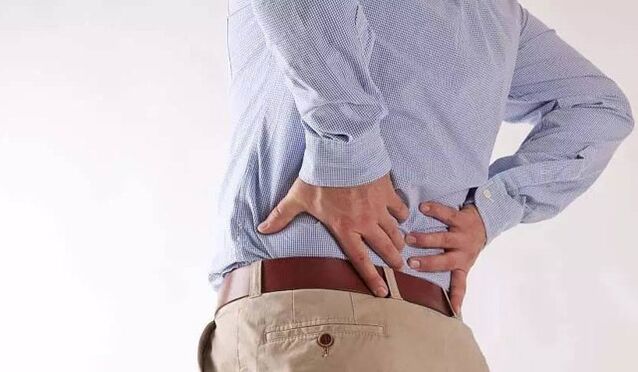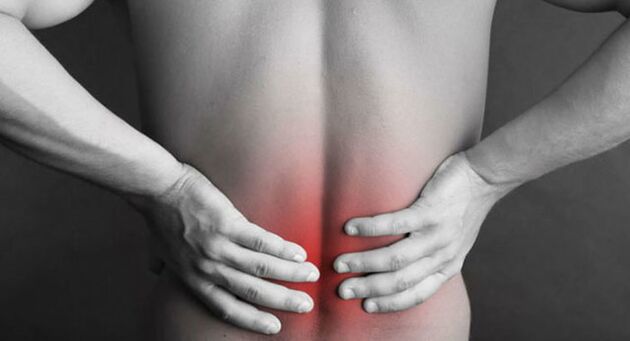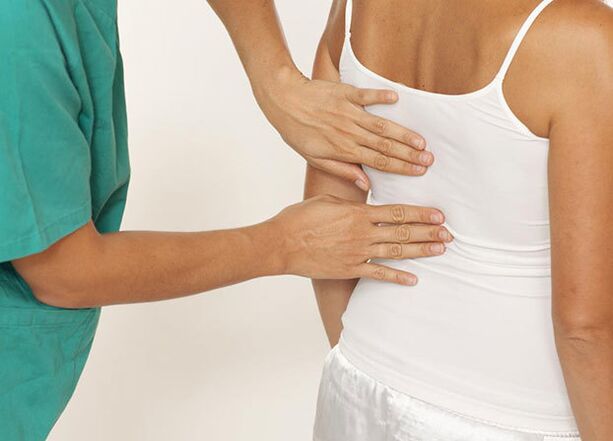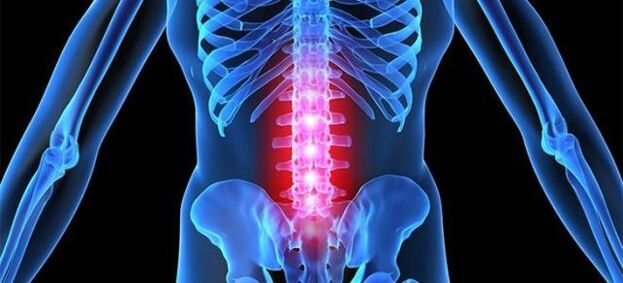About 80% of people over 55 years of age manifestation of various diseases in the back, they cannot ignore the younger age category. Therefore, one of the most common diseases of osteochondrosis of the lumbar spine column is also present in patients 25-45 years. Even young people aged 16-25 are experiencing symptoms and causes of this very unpleasant disease. The question is logical whether it is possible to stop the tendency of the number of patients in general, and what to do to everyone for preventive purposes so as not to be a victim of this pathology?

Symptom
With inadequate attention to the disease, the soon -out diagnosis, the treatment is difficult in secondary disease or complications. As a natural continuation of the pathology, osteochondrosis begins to develop. The treatment is not necessarily effective, and when tightening or the prescribed therapeutic course, the risk of defects occurs. Another feature problem is the appearance of intervertebral hernia, which is accompanied by uncertain sensations. Every day, the unprecedented opportunity to get rid of the lesser hernia.
Clinical symptoms of the feature help recognize the disease in the early stages and avoid these sad consequences:
- Sharp pain after night's sleep;
- Pain with sharp spread of the body or raises heavy objects;
- The body becomes inactive;
- Signs of scoliosis appear;
- Dreams become anxious;
- The atmosphere of depression arises;
- Frequently doubled.
Free assessment of these symptoms cannot be correct, as most of them have similar similarities to other signs of the spine or joints. Therefore, only rheumatologists or orthopedists have the ability to talk about the presence of osteochondrosis in the lumbar region.
Classification
Diagnosis of differentiation to determine the disease correctly, distinguishes it from the same pathology and determines the course of treatment, the stage classification of the disease helps:
- Level 1 - Currently, the new cartilage structure is changing. But now, the pathological process is influenced by the root of the nerve ending. As a result, pain is given to the feet. At the same time, blood flow is worsening and inflammation is born. The pain is acute or stupid, and appears mainly after reinforced load on the back axis;
- The 2nd level begins with the destruction of fibrous rings in the spine, while the cartilage is thinner, and the vertebra reduces the distance to each other. The pain in the second stage is sharp and sharp, sometimes unreasonable. During this time, spinal mobility across the axis is increasing, nerve pinching occurs, pressure on soft tissue muscle corset is created;
- Level 3 is characterized by strong compression of muscle fibers and nerve roots. Investigative cramps and pains with burning characters occur. In the field of defeat, the numbness feels. With the intensive development of the disease, signs of paresis and paralysis appear;
- Level 4 - period of growth of osteophytes (neoplasms with bone structure). At this stage, changes in degenerative properties are activated, arthrosis of the spine and joints appear. The back becomes inactive, and if there is no proper treatment - it does not move completely.
Diagnostic method
Given that although the ideal knowledge of the clinic and the classification of lumbar spinal osteochondrosis does not provide a complete idea of the pathological process he provoked, a doctor involved in the treatment of pathological processes in the spine, the disease of the diagnosis system:
- X -ray in frontal and lateral projections - allow for identification of axial deviations, osteophytic formation, vertebral anatomical abnormalities;
- Magnetic resonance imaging-Set the entire condition of the back damage zone, detecting destroyed vertebral fragments, cartilage and inflammation focus;
- Calculated tomography gives an idea of the state of soft tissue, vertebral bone, intervertebral disc shell, in principle, which is basically integrity. and blood circulation in the field of localization.

At the same time, the patient took the test for rheumatoid tests, general blood indications, biochemical components. The outcome of the overall survey allows you to establish an accurate diagnosis and identify the level of development of osteochondrosis in the lumbar region.
Symptoms and treatment of lumbar spinal osteochondrosis
Among the same causes of pain in the back, lumbar spinal osteochondrosis, symptoms, treatments that have their characteristics. The disease is an early stage of osteochondrosis associated with the process of destruction of cartilage rings, intervertebral discs, changes in their height towards reduction, swelling and pinching of nerve roots. Young and old people can cope with this disease, regardless of gender, social and religious status. The absence of a long manifestation of the symptoms of the disease leads to valuable time loss and the transition from one stage of disease to a worse form of development. The main features that distinguish osteochondrosis are the boundary zone of dystrophic changes in vertebral tissue, which does not exceed the articular cartilage.
The early stages of osteochondrosis
A number of external and internal factors determine the development of the pathological condition of the lumbar region. Lumbar osteochondrosis arises due to certain risk factors. These include:
- body aging after 50 years;
- improper posture and anomalous anatomical structure of the axis frame, which determines the uneven load on the vertebra;
- lifting weight with weak muscle frames;
- Hypothermia of the patient's body as a whole and the lower back separately;
- Metabolic process dysfunction, endocrine organ function, cardiovascular system;
- Uneven burden on the spine while performing production, homework, professional sports and amateur;
- pathology of the musculoskeletal system of natural or acquired nature;
- hypodynamia, high frequency of stress situation;
- overweight of the patient;
- vitamin deficiency, minerals, trace elements in the body of a sick person, responsible for spinal health;
- higher acquisition of shoes, uncomfortable platforms;
- The use of high pillows and soft mattresses during rest and sleep.
The frequency of diagnosis of osteochondrosis of the lumbar frame is determined by the number of risk factors for its development in the patient's life.
Diagnosis of a disease
Determination of degenerative-dystrophic lesions one of the five lumbar space vertebrae The axis frame provides diagnostic steps. They are prescribed by the doctor. In a consultation with experts who know how to treat lumbar osteochondrosis, the history of the disease is collected, the time and characteristics of the manifestation of the signs, the intensity and place of the painful localization of the sensation are explained. The state of the muscle fiber in the damage zone is determined by visual examination. Using the palpation method gives doctors the opportunity to see a picture of vertebral symmetry and the distance between them. The final diagnosis is established after the results of additional studies. These include:

- X -Ray, performed in two projections and provide the opportunity to see the position of the vertebra, the height of the disc, the marginal bone plate seal and growth;
- Magnetic resonance imaging, which is a special research method for determining the state of the vascular system and fibrous rings in the degenerative-dystrophic lesion zone.
Goals and methods of pathological treatment
The results of the diagnostic steps are the basis for the treatment regimen for osteochondrosis of the lumbar lumbar frame, which pursues a specific target. These include:
- decreased in the intensity of pain caused by degenerative-dystrophic lesions of one or more lumbar skeletal vertebrae;
- normalization of metabolic processes in cartilage, recovery and exception of their risk of destruction;
- reduction of burden on nerve fibers;
- increased blood flow in the spinal tissue using massage, physiotherapy procedure;
- Strengthening the axial frame of the axis with the therapeutic training recommended by the instructor.
Lumbar spinal chondrosis therapy, symptoms and treatments that have its own characteristics, consisting of pharmaceutical intake and use, traditional medicine recipes, unconventional treatment methods, including hirudotherapy. Effective additions in solving pathological problems are physiotherapy, water, massage procedures, gymnastics and sports, including special training. Drug therapy includes the use of drugs non -steroid anti -inflammation, muscle relaxants, chondroprotectors, vitamin complexes with trace and mineral elements.
With severe pain, novocaine or blockade lidocaine is prescribed, performed by introducing injections to affected places in the vertebra. For local use, ointment, gel, cream, patchings with heating, anti -anti -inflammatory effects are prescribed. Physiotherapy treatment includes electrophoresis healing courses, diadynamic current, exposure to ultravioletus, manual, shock and reflexological waves. In the absence of positive dynamics, the appearance of hernial protrusions, surgical surgery is prescribed. To prevent the development of complications with the appearance of the first symptom, treatment must begin immediately.
Lumbar osteochondrosis
Lumbar osteochondrosis is one of the most common forms of disease, actually osteochondrosis. Lumbar osteochondrosis, the same symptoms -are determined by men and women, which are indicated in the form of pain concentrated in the sacrum area, reflected in their symptoms and in the lower leg, which is often determined by the patient as "pinching the lumbar nerves".
Protrusion for lumbar osteochondrosis
Protests in the field of interest for us to grow most often, moreover, it is a protrusions that cause the appearance of pain in the lower back. The lumbar region itself, given its location and features, is most subject to the emergence of certain function problems. That is, when considering this statement on the one hand, it can be distinguished that our center of gravity directly refers to the lumbar department, respectively, is precisely on it that most of the load account. When considering, on the contrary, it can be noted that significant movement amplitude is, again, falling in the lumbar region. Given this, the biggest tendency to damage (as well as our protrusion of interest) is on the disc concentrated in the lumbar region. In addition, we must not forget that the disk changes in this and, of course, in other areas, occur, including the background of age -related degenerative processes.
Remember our readers what protrusion itself is. The disc connection with each other on the spine is provided by the wheels based on the cartilage. The main components of the intervertebral disc is the nucleus of the jetty and fibrous rings, where the setting is provided within the spinal disc frame. The effects of certain factors and conditions cause the possibility of breaking down this ring, on the next background, nucleus protrusion occurs. As a result of this process, the hernia grows. For highlights, it has evolved as a result of the same process, but without breaking the ring - in this case it is only subject to thinning, and not rest, as the core stands directly through the ring. In fact, this prominent is defined as a highlight.
For the symptom symptoms, it shows itself as follows:
- feeling of stiffness in the lower back;
- pain in the lumbar region;
- Lower pain than chronic nature;
- Radiculite lumbosacral;
- numbness, pain, fingers -tingling in the feet, on the feet;
- impaired urinary function (in cases of rare pathology considered).

Mostly, conservative treatment is used to highlight lumbar discs. Meanwhile, it is important in the development of protrusion that is often accompanied by severe symptoms, resistant to treatment, in this case, you can no longer do without surgical intervention.
Treatment
Most of the treatment of osteochondrosis is multicomponent and is quite complicated in its implementation. Most of all therapy measures are reduced to the following points:
- drug treatment;
- if necessary - surgical treatment;
- diet;
- Physical Education Medicine.
Increased disease requires, first of all, compliance with bed break for patients. The main suggestion for this section is a hard/hard bed. Highly stated in the manifestation, the attack provides the need for minimum motor load and in the initial contact with the relevant specialist.






















